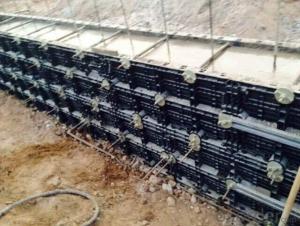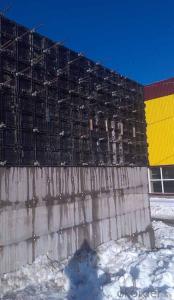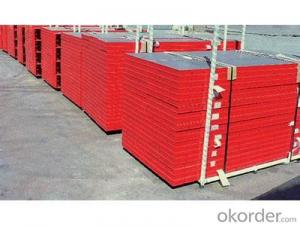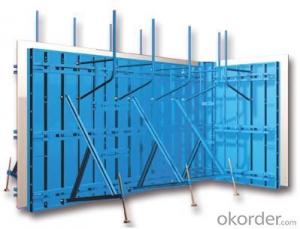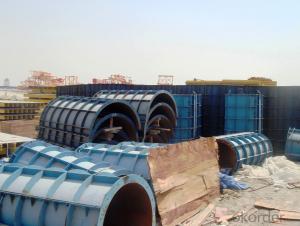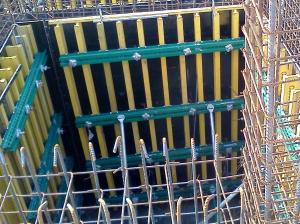New Type of Plastic Formworks Used in Constructions
- Loading Port:
- Shanghai
- Payment Terms:
- TT OR LC
- Min Order Qty:
- 1 m²
- Supply Capability:
- 100000 m²/month
OKorder Service Pledge
OKorder Financial Service
You Might Also Like
1.Main Introduction of PLASTIC FORMWORK:
The biggest panel is 120x60cm, weight only 10.5kg, which can be lift and set up by only one person easily, need no crane on the site.
2. The Advantages of PLASTIC FORMWROK:
-easy set up
Different size of panels can be firmly locked by simply turn the special handles to 90 degree. The panels have rib on the back, which makes the
system need not traditional wood blocks and nails. The panels have holes to fit tie rod, guarantee the strength of the whole system.
-modularity
Modular formwork composed by different size of panels, the main item is 120x60 panel, the size is 120x60cm, which used for the large area of walls
and slabs. There are also small size of panels like 10x60 panel (10x60cm), 20x60 panel (20x60cm), 25x60 panel (25x60cm), inner corner (20x20x60cm) and outer corner (10x5x60cm). Due to the variety of panel size, the system can form almost all size walls120x60 panel (act size 120x60cm) of multiple by 5cm. The material of modular formwork is PC-ABS mixied with special glass fibres which enable panels to hold high pressures.
-strength
The handles are made by high strength Nilon, each panel locked by at least 4 handls, which makes the whole system strong enough to pour 40cm walls.
-enviroment friendly
The system need not cut and nail due to the variety size, and nearly need no wood, the material can be recycled after broken, will not pollute the enviroment.
-consequent
Concrete does not stick to plastic, thus the panels need no oil before using, and can be cleaned simply by water. The surface of the wall which built by modular formwork is smooth, can be left without rework.
3. Images for Plastic formwork:
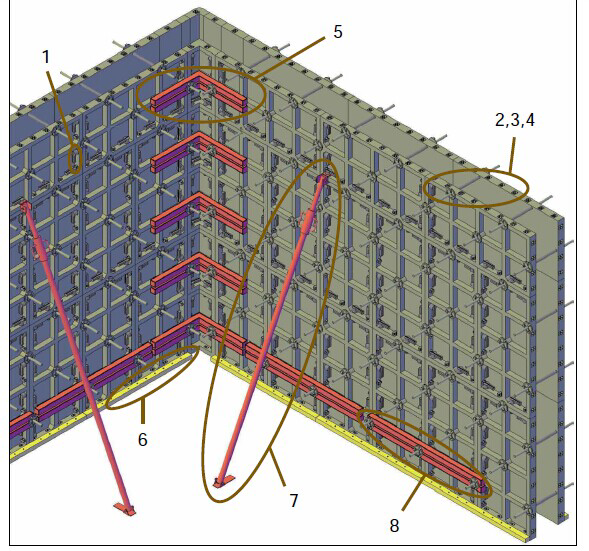
4. FAQ of Plastic formwork
1) What can we do for you?
We can ensure the quality of the vinyl banner and avoid extra expenses for customers.
.We can provide you the professional design team.
.We can provide fashionable and newest styles for you.
.We can design the artwork for you.
. Please feel free to customize.
2) What promises can be done by us?
. If interested in plastic formwork, please feel free to write us for any QUOTE.
. If printing required, please advise asap because the whole set need much more time to complete.
. Please DO check goods when courier knocks your door and contact us asap if any issue.
- Q:How does steel frame formwork handle the placement of fire-rated barriers and partitions within the concrete structure?
- Steel frame formwork provides a robust and efficient solution for the placement of fire-rated barriers and partitions within a concrete structure. With its strong and durable nature, steel frame formwork ensures the accurate positioning and alignment of these fire-rated elements. The rigid framework allows for precise installation, ensuring that the barriers and partitions are securely embedded within the concrete structure, providing reliable fire protection. Additionally, steel frame formwork allows for easy adjustment and modification when necessary, making it a versatile choice for incorporating fire-rated barriers and partitions into the concrete structure.
- Q:How does steel frame formwork handle the load distribution of a structure?
- A versatile and strong system utilized in construction for effective load distribution of structures is steel frame formwork. The main characteristic of this formwork is its ability to evenly distribute weight and forces on the structure, ensuring a stable and balanced load distribution. To begin with, steel frame formwork is comprised of interconnected rigid and strong steel panels capable of withstanding heavy loads. These panels are assembled and fixed together to create a framework that serves as a support system for the structure. The design of the steel frame formwork is such that it evenly distributes the load across the panels, preventing concentration of forces in specific areas. Moreover, steel frame formwork offers high customization, allowing for precise adjustment and alignment of the panels. This adaptability enables the formwork system to accommodate structures with complex geometries or irregular shapes. By ensuring accurate alignment of the panels, the load distribution is optimized, avoiding localized stress points and ensuring a uniform distribution of forces. Furthermore, steel frame formwork has a high load-bearing capacity due to the strength and durability of steel. Steel is known for its robustness and resistance to deformation, enabling it to handle heavy loads without compromising the stability of the structure. The use of steel in the formwork system ensures even and efficient load distribution, minimizing the risk of structural failure or collapse. Additionally, steel frame formwork allows for the integration of additional reinforcement elements, such as steel bars or mesh, which further enhance the load distribution capabilities of the structure. These reinforcements provide additional strength and stiffness, ensuring that the load is evenly distributed across the entire formwork system. In conclusion, steel frame formwork is an excellent solution for managing load distribution in structures. Its strength, adaptability, and high load-bearing capacity enable it to evenly distribute weight and forces on the structure, ensuring a stable and balanced load distribution. This guarantees the structural integrity and safety of the building, making steel frame formwork a popular choice in the construction industry.
- Q:How does steel frame formwork handle the placement of flooring and surface finishes within the concrete structure?
- Steel frame formwork is a versatile and efficient system that simplifies the placement of flooring and surface finishes within a concrete structure. The formwork's sturdy steel frames provide a secure and stable platform for pouring and shaping the concrete, ensuring a precise and level surface for the flooring. Additionally, the steel frame formwork allows for easy installation of various surface finishes, such as tiles or epoxy coatings, as it provides a smooth and even base for these materials to adhere to. Overall, steel frame formwork streamlines the process of placing flooring and surface finishes, resulting in a high-quality and aesthetically pleasing end product.
- Q:What are the advantages of steel frame structure
- Earthquake: the roof of low rise villas are sloping roof, the roof structure basically adopts the triangular truss system made of cold-formed steel, light steel members in sealed end structural plate and plaster board, formed a very strong "plate structure", this kind of structure system with the capacity of earthquake and stronger resistance to horizontal loads, suitable for seismic intensity of 8 degrees above the area.
- Q:Can steel frame formwork be used for both plain and reinforced concrete structures?
- Yes, steel frame formwork can be used for both plain and reinforced concrete structures. Steel frame formwork is a versatile and durable formwork system that can be used for various types of concrete structures. It provides a strong and stable framework that can withstand the pressure exerted by both plain and reinforced concrete during the pouring and curing process. The steel frame formwork can be easily adjusted and customized to accommodate different shapes and sizes of structures, making it suitable for use in various construction projects. Additionally, steel frame formwork offers good dimensional accuracy, ensuring that the concrete structure is built according to the required specifications. Overall, steel frame formwork is a reliable and efficient solution for constructing both plain and reinforced concrete structures.
- Q:How does steel frame formwork compare to timber formwork in terms of cost?
- In terms of cost, steel frame formwork generally tends to be more expensive compared to timber formwork. This is mainly due to the higher material and manufacturing costs associated with steel. Steel frame formwork requires the use of steel beams, panels, and other components, which are typically more expensive than timber materials. Additionally, constructing steel formwork requires specialized skills and equipment, which can further increase the overall cost. On the other hand, timber formwork is relatively more affordable as timber materials are generally cheaper and readily available. However, it is important to note that despite its initial higher cost, steel frame formwork offers several advantages that can contribute to cost savings in the long run. Steel formwork is more durable and has a longer lifespan compared to timber formwork, which can result in reduced maintenance and replacement costs over time. Moreover, the reusability of steel formwork is another cost-saving factor. Steel frames can be easily dismantled, transported, and reused for multiple construction projects, whereas timber formwork may need to be replaced after a few uses due to wear and tear. Ultimately, when considering the cost of formwork, it is essential to evaluate the specific needs and requirements of the project, as well as the expected lifespan and potential for reuse. While steel frame formwork may initially have a higher price tag, its durability and reusability can make it a more cost-effective choice in the long term, particularly for larger or repetitive projects. Conversely, timber formwork may be more suitable for smaller or one-time projects where cost efficiency is a primary concern.
- Q:How does steel frame formwork contribute to the overall durability of a structure?
- Steel frame formwork contributes to the overall durability of a structure by providing a strong and rigid framework that supports the weight of the concrete during construction. This ensures that the structure is built with precision and accuracy, minimizing any potential for structural weaknesses or defects. Additionally, the steel frame formwork is highly resistant to warping, bending, and corrosion, which helps maintain the integrity and longevity of the structure over time.
- Q:Can steel frame formwork be used in combination with other types of formwork systems?
- Yes, steel frame formwork can be used in combination with other types of formwork systems. Steel frame formwork provides a strong and durable framework for concrete placement, allowing for the creation of various shapes and sizes. It can be used in conjunction with other types of formwork systems such as timber formwork, aluminum formwork, or plastic formwork to enhance the efficiency and versatility of the construction process. By combining different formwork systems, construction professionals can take advantage of the unique features offered by each system. For example, steel frame formwork provides high load-bearing capacity and stability, making it suitable for large-scale projects or structures with complex geometries. On the other hand, timber formwork may be more cost-effective and easier to handle for smaller projects or when a specific surface finish is desired. The combination of steel frame formwork with other formwork systems allows for greater flexibility and adaptability in construction projects. It enables contractors to customize the formwork design according to the specific requirements of each section of the structure, optimizing the use of resources and reducing construction time. However, when using a combination of formwork systems, it is important to ensure compatibility and proper integration between the different components. This can be achieved through careful planning, coordination, and supervision to guarantee the stability and safety of the formwork structure. In summary, steel frame formwork can be effectively used in combination with other types of formwork systems, providing construction professionals with a wider range of options to meet the specific needs of each project.
- Q:Can steel frame formwork be used for both small and large-scale bridge construction projects?
- Yes, steel frame formwork can be used for both small and large-scale bridge construction projects. Steel frame formwork offers several advantages that make it suitable for bridge construction. Firstly, steel is a strong and durable material that can withstand the heavy loads and stresses associated with bridge construction. It provides the necessary support and stability required for constructing both small and large-scale bridges. Additionally, steel frame formwork is highly versatile and flexible, allowing for customization and adaptability to different bridge designs and dimensions. This makes it suitable for constructing bridges of varying sizes and complexities. Furthermore, steel frame formwork is known for its efficiency and ease of use. It can be easily assembled, disassembled, and reused, which is beneficial for both small and large-scale projects. This not only saves time but also reduces costs associated with formwork materials. Moreover, steel frame formwork provides excellent concrete finish, ensuring the structural integrity and aesthetic appeal of the bridge. The smooth and even surface it creates helps in achieving the desired quality and appearance of the bridge. Overall, steel frame formwork is a suitable choice for both small and large-scale bridge construction projects due to its strength, versatility, efficiency, and ability to provide a high-quality finish.
- Q:How long does steel frame formwork last?
- The lifespan of steel frame formwork may vary depending on various factors, including the quality of the formwork material, appropriate maintenance, and the intensity of usage. Generally, steel frame formwork is renowned for its durability and long-lasting nature. Through adequate care and maintenance, it can endure for numerous years, often surpassing the lifespan of alternative formwork materials like timber or aluminum. Typically, steel frame formwork can be reused for multiple construction projects, presenting a cost-effective option for contractors. Nevertheless, it is crucial to regularly evaluate the condition of the formwork and replace any damaged or worn-out components to ensure safety and optimal performance.
1. Manufacturer Overview |
|
|---|---|
| Location | |
| Year Established | |
| Annual Output Value | |
| Main Markets | |
| Company Certifications | |
2. Manufacturer Certificates |
|
|---|---|
| a) Certification Name | |
| Range | |
| Reference | |
| Validity Period | |
3. Manufacturer Capability |
|
|---|---|
| a)Trade Capacity | |
| Nearest Port | |
| Export Percentage | |
| No.of Employees in Trade Department | |
| Language Spoken: | |
| b)Factory Information | |
| Factory Size: | |
| No. of Production Lines | |
| Contract Manufacturing | |
| Product Price Range | |
Send your message to us
New Type of Plastic Formworks Used in Constructions
- Loading Port:
- Shanghai
- Payment Terms:
- TT OR LC
- Min Order Qty:
- 1 m²
- Supply Capability:
- 100000 m²/month
OKorder Service Pledge
OKorder Financial Service
Similar products
New products
Hot products
